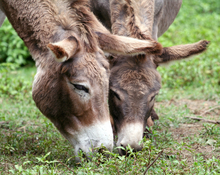A recent study in Italy reported in BioMed Central Veterinary Research examined the presence of Equine piroplasmosis in donkeys in Italy. Equine piroplasmosis is a tickborne disease caused by the protozoa Babesia caballi and Theileria equi. EP is endemic in most equine populations in tropical and subtropical areas of the world and affects all equid species, including horses, donkeys, mules, and zebras.

Susceptibility of donkeys to equine diseases
A recent study focused on the different reactions in donkeys as compared to horses with natural piroplasmosis infection.
Chronic cases are more common in donkeys than horses and are usually characterized by nonspecific clinical signs such as lethargy, partial anorexia, poor work performance and body weight loss.
In acute forms of EP, donkeys can show fever, listlessness, depression, noticeable thirst, swelling of the eyelids, constipation, presence of yellow mucous covering feces, yellowish coloration of urine, and splenomegaly].
Donkeys can also show an asymptomatic form of the infection and, in comparison to horses, they also show a lower parasitemia. The most common hematological alteration found in horses is decreased packed cell volume, hemoglobin and erythrocyte number, in addition to hyperbilirubinemia and thrombocytopenia.
After subclinical, chronic or acute infection, donkeys usually remain asymptomatic carriers with positive antibody titers throughout life.
Interest in the welfare and diseases of donkeys is constantly increasing in several countries including Italy, where a recent study focused on the different reactions in donkeys as compared to horses with natural piroplasmosis infection.
During the study, venous blood samples were taken from one hundred and thirty eight donkeys and underwent indirect fluorescent antibody test (IFAT) to detect IgG antibodies against Theileria equi and Babesia caballi and real-time polimerase chain reaction (PCR) to detect Babesia spp. and Theileria spp.
Clinical examinations, haematological analyses and serum bilirubin evaluation were also performed and compared with positive or negative status. A seroprevalence of 40.6% and 47.8% was found for T. equi and B. caballi, respectively; double positivity was detected in 19.6% of the animals. PCR results showed that 17.4% of the animals tested positive for T.equi and 3.6% for B. caballi with no double positivity.
Twelve donkeys (8.7%) had clinical signs consistent with chronic forms of the disease and no acute forms were detected. Fifty-eight donkeys had haematological and serum bilirubin alterations and 56 (96.6%) of them were IFAT and/or PCR positive. Changes in erythrocyte number, packed cell volume, hemoglobin concentration, mean corpuscular hemoglobin, platelets number and total bilirubin were significantly associated with positive and symptomatic animals.
Conclusion
Nonspecific clinical presentation seems to be very common in donkeys and several clinical pathology alterations persist after natural infection. Therefore, apparently healthy donkeys can have masked but severe clinical pathology alterations. Acute forms are very seldom observed in donkeys.
Clinical monitoring of chronically infected donkeys is recommended since such animals represent a risk both for transmission to other animals and for their own health; furthermore, their production performances could be reduced.
The study should also be intended as a contribution for veterinary practitioners because it describes the most usual clinical presentations and laboratory findings of equine piroplasmosis in naturally infected donkeys in endemic areas.
